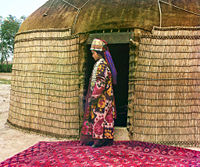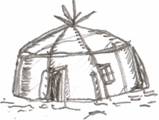Yurt
A yurt is a portable, felt-covered, wood lattice-framed dwelling structure used by nomads in the steppes of Central Asia.
Origin
The word yurt is originally from the Turkic word meaning "dwelling place" in the sense of "homeland"; the term came to be used in reference to the physical tent-like structures only in other languages. In Russian the structure is called "yurta" (юрта), whence the word came into English.
In Kazakh (and Uyghur) the term for the structure is kiyiz üy (киіз үй, lit. "felt home"). In Kyrgyz the term is boz üý (боз үй), literally "grey house," because of the colour of the felt. In Mongolian it is called a ger (гэр). Afghans call them "Kherga"/"Jirga" or "ooee." In Pakistan it is also known as gher (گھر). In Hindi, it is called ghar (घर), which means Home.
Construction
Traditional yurts consist of a circular wooden frame carrying a felt cover. The felt is made from the wool of the flocks of sheep that accompany the pastoralists. The timber to make the external structure is not to be found on the treeless steppes, and must be traded for in the valleys below.
The frame consists of one or more lattice wall-sections, a door-frame, roof poles and a crown. Some styles of yurt have one or more columns to support the crown. The (self-supporting) wood frame is covered with pieces of felt. Depending on availability, the felt is additionally covered with canvas and/or sun-covers. The frame is held together with one or more ropes or ribbons. The structure is kept under compression by the weight of the covers, sometimes supplemented by a heavy weight hung from the center of the roof. They vary regionally, with straight or bent roof-poles, different sizes, and relative weight.
It is designed to be dismantled and the parts carried on camels or yaks to be rebuilt on another site.
Use
Symbolism
- Coat of arms of Kazakhstan (flat).svg
Kazakh coat of arms
The wooden lattice crown of the yurt, the shangrak (Mongolian: тооно, toono; Kazakh: Шаңырақ, shangyraq; Kyrgyz: түндүк, tunduk) is itself emblematic in many Central Asian cultures. In old Kazakh communities, the yurt itself would often be repaired and rebuilt, but the shangrak would remain intact, passed from father to son upon the father's death. A family's length of heritage could be measured by the accumulation of stains on the shangrak from generations of smoke passing through it. A stylized version of the crown is in the center of the Coat of arms of Kazakhstan, and forms the main image on the flag of Kyrgyzstan.
Variations
Western yurts

Enthusiasts in other countries have taken the visual idea of the yurt—a round, semi-permanent tent—and have adapted it to their cultural needs. Although those structures may be copied to some extent from the originals found in Central Asia, they have been greatly changed and adapted and are in most cases very different.
In the United States and Canada, yurts are made using hi-tech materials. They are highly engineered and built for extreme weather conditions. In addition, erecting one can take days and they are not intended to be moved often. Often the designs of these North American yurts barely resemble the originals; they are better named yurt derivations, because they are no longer round felt homes that are easy to mount, dismount and transport. North American yurts and yurt derivations were pioneered by William Coperthwaite (founder of the Yurt Foundation) in the 1960s[1], after he was inspired to build them by an article about Supreme Court Justice William O. Douglas's visit to Mongolia[2].
In Europe, a closer approximation to the Mongolian and Central Asian yurt is in production in several countries. These tents use local hardwood, and often are adapted for a wetter climate with steeper roof profiles and waterproof canvas. In essence they are yurts, but some lack the felt cover that is present in traditional yurt.
Different groups and individuals use yurts for a variety of purposes, from full-time housing to school rooms. In some provincial parks in Canada, and state parks in several US states, permanent yurts are available for camping.
Yaranga
Yaranga is a tent-like traditional mobile home of some nomadic Northern indigenous peoples of Russia, such as Chukchi and Siberian Yupik.
Yaranga is a cone-shaped or rounded reindeer-hide tent.[3] It is built of a light wooden frame covered with reindeer skins or canvas sewn together.
The word yaranga comes from the Chukchi language.[4] In Russian use, the terms chum, yurt and yaranga may be used indiscriminately.
The Chukchi yaranga is built of a light wooden frame covered with reindeer skins sewn together. A medium-size yaranga requires about 50 skins.
A large yaranga is hard to heat completely up. There is a smaller cabin built inside in it, that can be kept warm and cosy.[5]
The largest of Siberian Yupik peoples, the Chaplino Eskimos (Ungazigmit) had a round, dome-shaped building for winter. It is called "yaranga" in the literature: the same word refers also to the similar building of the Chukchi. In the language of Chaplino Eskimos (the largest of Siberian Yupik languages), its name was /mɨŋtˈtɨʁaq/.[6] Its framework was made of posts.[7] Canvas was used for the covering the framework. The yaranga was surrounded by sod or planking at the lower part. There was a smaller cabin inside it at its back part, used for sleeping and living. It was separated from the outer, cooler parts of the yaranga with haired reindeer skins and grass, supported by a cage-like framework. In the language of Chaplino Eskimos, it was called /aːɣra/, a word borrowed from Chukchi language. But the household works were done in the room of the yaranga in front of this inner building, and also many household utensils were kept there. In winter storms, and at night also the dogs were there. This room for economical purposes was called /naˈtɨk/.[8]
Notes
- ↑ YurtPeople.com - History of North American Yurts, webpage, retrieved February 9, 2007
- ↑ Article at Alternatives Magazine on North American Yurts, webpage, retrieved February 9, 2006
- ↑ Countries and Their Cultures - Chukchi: Living Conditions
- ↑ Collis, Dirmid R. F. "Arctic Languages: An Awakening." Unesco, 1990. page 72
- ↑ Chukchi art.
- ↑ Рубцова 1954: 514
- ↑ Рубцова 1954: 515
- ↑ Рубцова 1954: 100–101
ReferencesISBN links support NWE through referral fees
- Kemery, Becky. 2001. Yurts - Round and Unbound. Alternatives Magazine 18. Retrieved November 16, 2008.
- Kemery, Becky. 2006. Yurts: Living in the Round. Gibbs Smith, Publisher. ISBN 978-1586858919
- King, Paul. 2002. The Complete Yurt Handbook. Eco-Logic Books. ISBN 1899233083
- Kuehn, Dan Frank. 2006. Mongolian Cloud Houses: How to Make a Yurt and Live Comfortably. Shelter Publications. ISBN 978-0936070391
- Raitt, David. 2006. History. Vital Designs. Retrieved November 16, 2008.
External links
Background Information
Yurt Construction
- Simply Differently.org: Yurt Notes & Calculator, yurt building resources, how-to manuals and online calculator
- How to build a yurt by Paul King (PDF & HTML Book)
- Yurt Building - Documents the complete process of building a yurt from raw materials in pictures and text
- Kazakh Yurt Set-Up by Rebecca Schultz, informative video expose from Kazakh community in northwestern China.
Yaranga
- Chukchi art.
- Right-angled winter yaranga in Ungazik village (front view).
- Right-angled winter yaranga in Ungazik village (back view).
- Winter yaranga in Ungazik village.
- Winter tent in Ungazik village.
- Galmui's family.
- Attyrak fest at Eskimo Matlu - bidarrah settling.
- Attyrak fest at Eskimo Matlu - settling whalerboat control.
- Fest of Seal Heads at Eskimo Matlu - seal heads at tent.
- Fest of Seal Heads at Eskimo Matlu - common food.
Credits
New World Encyclopedia writers and editors rewrote and completed the Wikipedia article in accordance with New World Encyclopedia standards. This article abides by terms of the Creative Commons CC-by-sa 3.0 License (CC-by-sa), which may be used and disseminated with proper attribution. Credit is due under the terms of this license that can reference both the New World Encyclopedia contributors and the selfless volunteer contributors of the Wikimedia Foundation. To cite this article click here for a list of acceptable citing formats.The history of earlier contributions by wikipedians is accessible to researchers here:
The history of this article since it was imported to New World Encyclopedia:
Note: Some restrictions may apply to use of individual images which are separately licensed.











